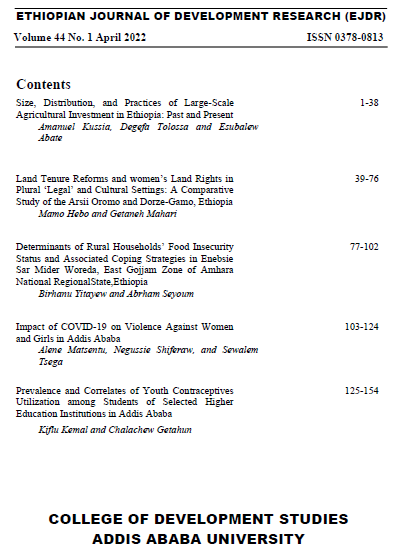Impact of COVID-19 on Violence Against Women and Girls in Addis Ababa
DOI:
https://doi.org/10.20372/ejdr.v44i1.4398Keywords:
COVID-19, Girls, Women, Violence, ImpactsAbstract
There is no doubt that promoting a safer, Gender-Based Violence (GBV)
free environment for women and girls gives them greater safety and
security, better health and education, and, more control over their life
choices. The main objective of the study was to explore the impacts of
COVID-19 in relation to violence against women and girls in Addis
Ababa. A Cross-sectional study design with concurrent mixed study
method was employed. Primary data was collected from 1084 women
(15-49 years old) selected using three-stage stratified sampling procedure,
12 key informants and one case study. Data were collected using
household survey questionnaire, key informant interview and in-depth
interview guides. The odds of gender-based violence was higher by at
least 1.6 times among women and girls who had no formal education and
primary education compared to those who had secondary and above level
of education. Women and girls residing in large household size (6+) had
significantly higher odds of gender-based violence compared to those
who were living in households with less than six members. Women and
girls who were living in rented house were 1.3 times more likely to be
exposed to gender-based violence compared to those living in their own
house. There should be aggressive and continuous community education
through behavioral change communication strategies that will eventually help
to significantly promote knowledge and attitude on adverse effects of gender-based violence
Downloads
Published
How to Cite
Issue
Section
License
Copyright (c) 2023 Alene Matsentu, Negussie Shiferaw, Sewalem Tsega

This work is licensed under a Creative Commons Attribution 4.0 International License.


